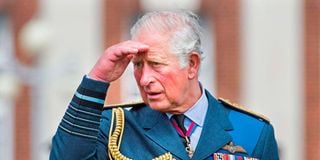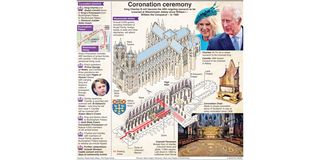President Ruto joins world leaders for historic Sh17bn coronation

King Charles III.
The world will be treated to a show of grandeur and opulence involving the United Kingdom’s monarchy today when King Charles III is coronated as the territory’s 62nd monarch at Westminster in London.
President William Ruto flew out of the country on May 5 evening to attend the event that is expected to cost £100 million (Sh17.1 billion) and bring together more than 12,000 people.
A select troop of Kenyan soldiers will also join soldiers from across the globe who will march at the occasion.
The event, according to the official website of the royal family, requires heavy deployment of armed forces.
“More than 6,000 men and women of the UK’s armed forces – and nearly 400 armed forces personnel from at least 35 Commonwealth countries – will take part,” says an article on the royal family’s official website.
Many will be cheering for the king as he takes oath.
But some Kenyans will be happier. They include two organisations that are part of a charity that King Charles started in 1976. The charity is called Prince’s Trust International. Shujaaz Inc – the makers of the booklets that this newspaper distributes – and Asante Africa Foundation, are the two organisations that have been getting support from the charity.
Some Kenyans will also have memories of his stay in the country.
Since 1969, King Charles has visited 48 Commonwealth countries, one of them being Kenya in February 1972 in the company of Princess Anne,his sister. During his visit, he sat with Kenyan orphans and watched a football match at Starehe Boys Centre in Nairobi, Kenya, as reported by the Royal Collection Trust.
Today’s coronation will be momentous in every aspect. When the world marvelled at the elaborate, culture-rich crowning of Queen Elizabeth II in 1952, King Charles was only three years old. Being the firstborn, he effectively became the heir apparent.
King Charles then became the Prince of Wales. He would then have the longest wait in history before ascending to the throne.
Today, 70 years after the coronation of Queen Elizabeth (and it was the first ever to be televised) the UK is pulling all the stops in a three-day jamboree that will feature nationwide street parties, a Windsor concert, and a symbolic ceremony at Westminster Abbey where the actual crowning will happen, and later a grand public procession.
The intricacies that went into the planning and execution of the 40th British ruler to be crowned at Abbey, make a child’s play of known handover traditions around the world.
To begin with, the oil which will be used to anoint King Charles III has been consecrated in Jerusalem, 4,800 kilometres away from London.
According to the official website of the British royal family, olive oils from the Mount of Olives, not far from the King’s grandmother Princess Alice’s crypt, “were mixed as part of making the chrism oil”.
King Charles legally ascended to the throne as soon as Queen Elizabeth died last September. The coronation serves as a religious ceremony to formalise Charles’ new status as king. That is why the presiding person is the Archbishop of Canterbury, the ceremonial head of the Anglican church worldwide.
“It’s also a moment of national celebration (and royalist propaganda), welcoming the new king to his station as the country moves away from mourning his long-reigning mother,” Vox News, a British news outlet, explains.
Westminster Abbey has been the setting for every coronation since 1066. Before the Abbey was built, the events were carried out in Bath, Oxford and Canterbury, wherever was convenient.
British coronation exists as a symbol and every single detail of the festivities has some long-held symbolic meaning.
This morning, King Charles and his wife Camilla will travel from Buckingham Palace to Westminster Abbey in the horse-drawn State Coach amid melodious music in the Abbey.
Charles and Camilla will arrive at Westminster Abbey at 11am (2pm East African time) to begin the ceremony, which will be led by the current Archbishop of Canterbury, Justin Welby.
The ceremony typically has six parts, first being the recognition where the archbishop presents the monarch to the gathering in the Abbey as they shout, “God save the king!” and trumpets sound.
Second, the archbishop administers the oath to the monarch, who swears to uphold the law and the Church of England, which traditionally is headed by the reigning ruler.
Third comes the anointing, with the archbishop painting the monarch with holy oil, symbolising the king’s consecration as monarch by God.
The anointing is traditionally considered too sacred to be shown to the public, so Charles will most likely be veiled from the cameras with a canopy of gold cloth during this portion of the proceedings.
Fourth is the investiture, in which the king sits on the Coronation Chair to be presented with the Royal Orb, the two Sovereign’s Sceptres, and the crown.
“The King will be crowned in St Edward’s Chair, made in 1300 for Edward I and used at every Coronation since that time. It is permanently kept in Westminster Abbey,” says the royal family’s website.
Fifth comes the enthronement and homage, when the king leaves the Coronation Chair and moves to the throne.
In-between, there will be the crowning of Camilla as queen.
“For the first time since 1937, the coronation of King Charles III will include the crowning of a Queen Consort. Queen Elizabeth, wife of King George VI, was the last Queen Consort to be crowned,” says the royal family.
Finally, King Charles and Queen Consort Camilla will leave Westminster Abbey and go back to Buckingham Palace in an 18th-century gold state coach, accompanied by armed forces from throughout the British Commonwealth. It is expected that the Kenyan group will take part here.
Once at Buckingham Palace, the monarchs will receive a royal salute and three cheers from the military.
The rest of the weekend will be spent in extended festivities, including a concert at Windsor Castle on Sunday, with American pop sensation Katy Perry set to perform.

Monday will be a public holiday in the UK, and citizens are encouraged to spend it on community service.
Unlike the last coronation of 1953 today’s – dubbed Operation Golden Orb – will be less elaborate, with a shorter duration and fewer attendees, owing to what the palace has explained as austerity measures due to “King Charles’s sensitivity to the cost-of-living crisis” as reported by Time magazine.
Being a lover of music (he played the piano, trumpet and cello while in school), King Charles is said to have commissioned 12 new pieces of music by composers throughout the British Commonwealth, including a new Coronation Anthem by Lord Andrew Lloyd Webber and a piece written for a gospel choir by Debbie Wiseman. Six of the new songs are purely orchestral, and they’ll play before the service begins.
King Charles holds unique attributes such as being the first heir to the throne to earn a university degree.
“The King studied archaeology and anthropology in his first year at the University of Cambridge, switching to history for the remainder of his degree,” says the royal family.
He also became the first member of The Royal Family to successfully complete the parachute regiment’s training course, before he was appointed Colonel-in-Chief of the Regiment in 1977.
There’s going to be a lot of heavily symbolic ritual going down over the course of the ceremony, some of it stretching back before the Norman conquest of England in 1066, and some of it brand new for the occasion.






